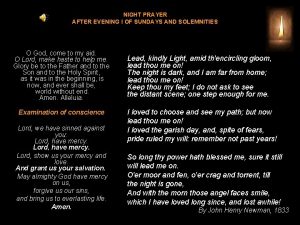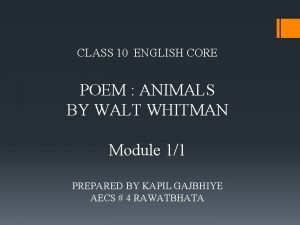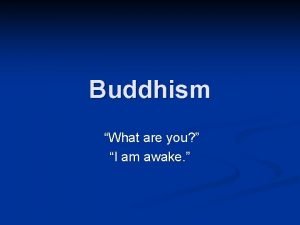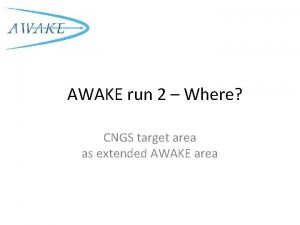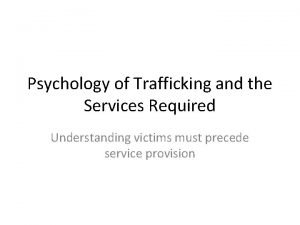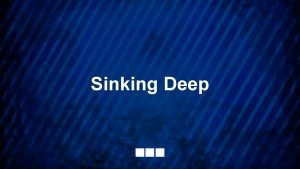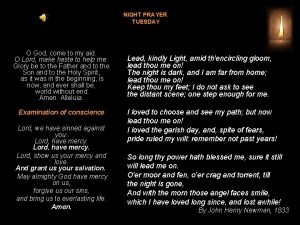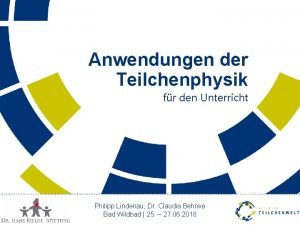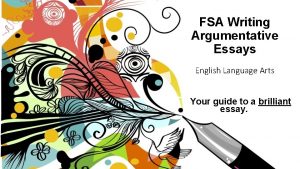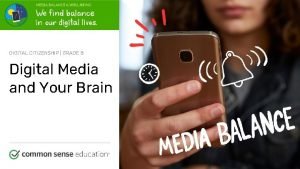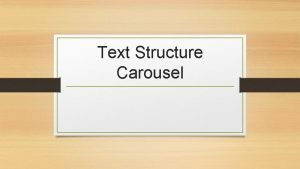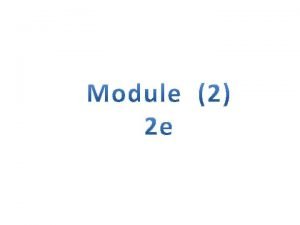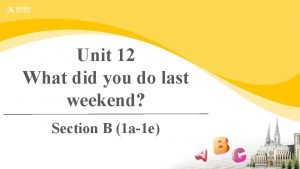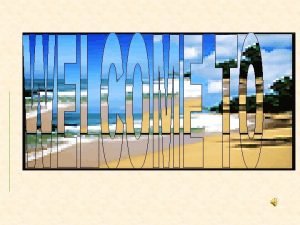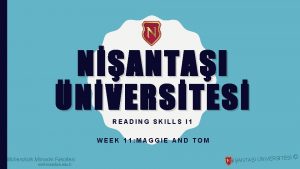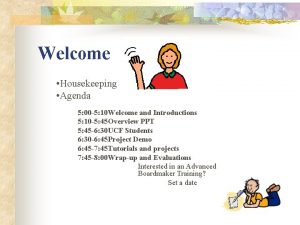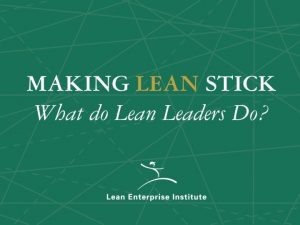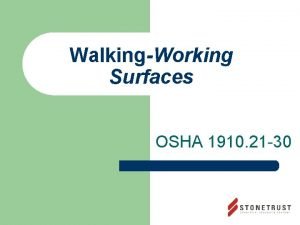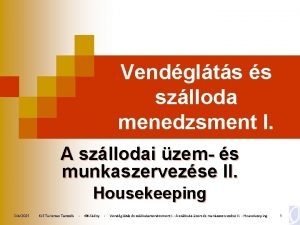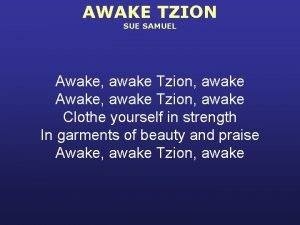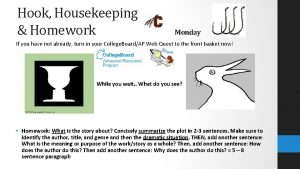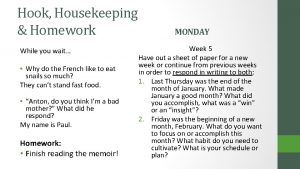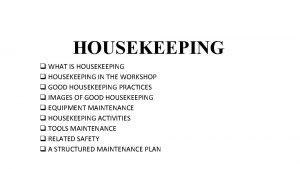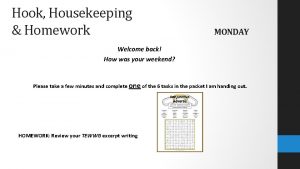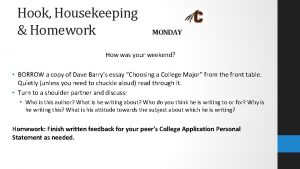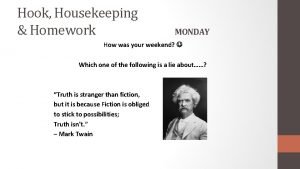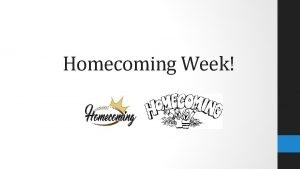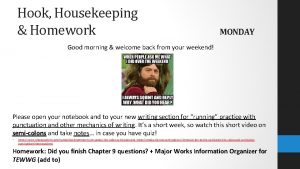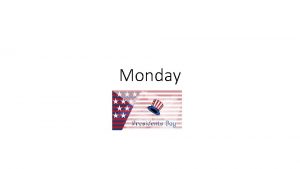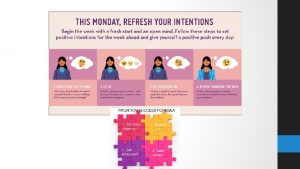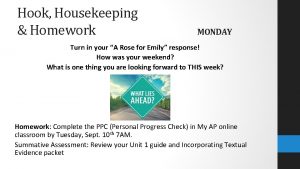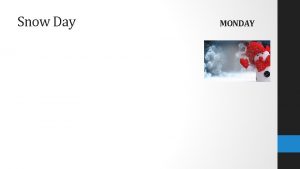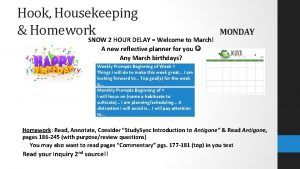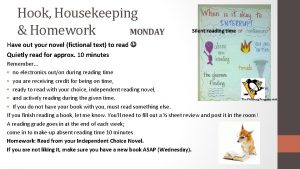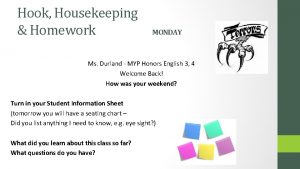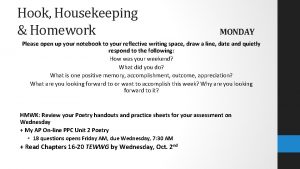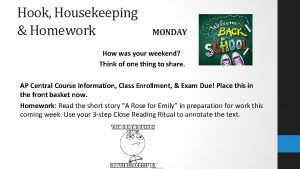Hook Housekeeping Homework How awake are you Q









































- Slides: 41

Hook, Housekeeping & Homework How awake are you? Q: Why did the nose not want to go to school? A: He was tired of getting picked on! Q: How do you get straight A's? A: By using a ruler! Q: Why did the kid study in the airplane? A: Because he wanted a higher education! Q: What object is king of the classroom? A: The ruler! Q: What did the pencil sharpener say to the pencil? A: Stop going in circles and get to the point! Q: Why did the clock in the cafeteria run slow? A: It always went back four seconds. Q: Why didn't the sun go to college? A: Because it already had a million degrees! Q: What did you learn in school today? A: Not enough, I have to go back tomorrow! MONDAY

Past, Present, Future MONDAY • “Don’t Eat the Marshmallow!” (de Posada TEDTalk video) + “Three Ways to Develop Intrinsic Motivation in Teens” (New York Times blog article) = Apply to Research Question + “Driven to Distraction” (Larry Rosen) • “Driven to Distraction” – Larry Rosen article – Q & A • • • Written Formative #1: Models & Self-Assessment Personal Project – Refine Goal Statement & return to Naviance Written Formative 2! “The Psychology of Stress” – Carol Dweck video – Chart “How to Make Stress Your Friend” – Kelly Mc. Gonigal video

Instruction: Obtain Unit 1 Guide: Being Teen Standard(s) 2. Reading for All Purposes 4. Read a wide range of informational texts to build knowledge and to better understand the human experience. Objectives: • Reading: Read closely to determine what the text says explicitly, to make logical inferences from it, & to cite strong and thorough textual evidence in order to support analysis of complex texts. • Research: Use a research question to guide research and learning & gather information from multiple research sources to answer a question or complete a project, propose solutions, or share findings and conclusions. • Writing & Speaking: Write texts to develop a topic, to clearly & accurately convey complex ideas, concepts, and information through the effective selection, organization, and analysis of content; develop the topic with well-chosen, relevant, and sufficient facts, concrete details, quotations, or other information and examples, and logical explanations and analysis. Relevance: By examining what others think and say, we can learn more about our own belief systems and take action on what is important to us. Through practicing the close reading skills that are needed in the research process, we are honing our skills for any inquires we have in our future (selecting a college, buying a car, etc. ) Essential Questions: What are the most important considerations one should make when developing a beneficial learning environment for teens?

Activity: Develop & Apply Purpose: to deepen your knowledge and understanding of the text through oral discussion with peers & written responses to text-dependent questions. Tasks: 1. Step 2: During Reading = What? How? Look for Patterns • Finish annotation Rosens’ “Driven to Distraction” • Visualize – Clarify – Respond – Summarize – Connect – Question 2. Step 3: After Reading = Why? So what? Come to a New Understanding • Share and compare your annotations of the article. Use this to help sharpen your understanding of the audience, main ideas and key supporting details of the article. • Discuss the Text Questions that follow and then respond in writing. • Review by applying SOAPSTone Outcome: Based on the Rosen article, what could you apply to our research question? What are the most important considerations one should make when developing a beneficial learning environment for teens?

Review & Release What new understanding or learning do you have today? Outcome: Based on the Rosen article, what could you apply to our research question? What are the most important considerations one should make when developing a beneficial learning environment for teens? • • • What are the most important considerations one should make when developing a beneficial learning environment for teens? Identify a Point Exemplify the point with an illustration from the text (“signal phrase/tagline”) Explain the illustration (how it supports your point) Elaborate on the idea further (why is this important; so what is the purpose in a larger context or effect on the reader) Make sure that you have re-examined your Personal Project Goal Statement, been in Naviance, and met your mentor!

Hook, Housekeeping & Homework TUESDAY What do these words mean in this class in relation to writing? • Thesis • Identify • Exemplify • Signal phrase • Explain • Elaborate • • Finish whatever revisions you need to on this formative so that you have ideas for your next formative and summative! Make sure that you have re-examined your Personal Project Goal Statement, been in Naviance, and met your mentor!

Past, Present, Future TUESDAY • “Driven to Distraction” – Larry Rosen article – Q & A • Written Formative #1: Models & Self-Assessment • • PSAT Scores from last year (take to math class!) Written Formative #1: Re-write Personal Project – Refine Goal Statement & return to Naviance Written Formative #2!

Instruction: Obtain Unit 1 Guide: Being Teen Standard(s) 2. Reading for All Purposes 4. Read a wide range of informational texts to build knowledge and to better understand the human experience. Objectives: • Reading: Read closely to determine what the text says explicitly, to make logical inferences from it, & to cite strong and thorough textual evidence in order to support analysis of complex texts. • Research: Use a research question to guide research and learning & gather information from multiple research sources to answer a question or complete a project, propose solutions, or share findings and conclusions. • Writing & Speaking: Write texts to develop a topic, to clearly & accurately convey complex ideas, concepts, and information through the effective selection, organization, and analysis of content; develop the topic with well-chosen, relevant, and sufficient facts, concrete details, quotations, or other information and examples, and logical explanations and analysis. Relevance: By examining what others think and say, we can learn more about our own belief systems and take action on what is important to us. Through practicing the close reading skills that are needed in the research process, we are honing our skills for any inquires we have in our future (selecting a college, buying a car, etc. ) Essential Questions: What are the most important considerations one should make when developing a beneficial learning environment for teens?

Activity: Develop Purpose: To examine effective organization and perceptive content in order to prepare for your next written formative Tasks: Read thorough the model and annotate it (see handout & next) • Thesis • Identification (ID) of point (topic sentence) – related to thesis but not repeating it • Exemplification (example/text evidence) • Signal phrase & documentation formatting • Who wrote/spoke – source within source? • Sources – “Article Title” & Larger Source Titles & (page reference) • Explanation – approx. 2 sentences explain the quote and how it supports your identified (ID) point • Elaboration – approx. 2 sentences that continue to develop details, may go beyond text, may include more specific examples to clarify understanding, may show “real world” examples, tells the readers why this is important, its implications, effect Outcome: Let’s look at a few peer models and hear my +- comments (see handout & next) Then, let’s assess our own!

Instruction: Obtain Model Research Question: What are the most important considerations one should make when developing a beneficial learning environment for teens? Thesis: When developing a favorable place for teens to learn, one should consider that students’ brains are still growing. • IDENTIFY: The ongoing growth of the teen brain provides not only a need but an opportunity to teach strategies to develop self control. • EXEMPLIFY: In the “Don’t eat the marshmallow!” Ted. Talk, speaker Joachim de Posada asserts that the ability to delay gratification, as seen in the Standford marshmallow test as well as other re-creations, leads to success in life (01: 30) , and he explains that “we need to learn that principle [of self discipline] here in the States because we have a big debt. ” (5: 22) • EXPLAIN: If young children do not know how to put off their initial impulses, then they may develop habits which cause them to miss out on more positive consequences but will also struggle with future opportunities and successes. Thus, children must be taught how to cope with these impulses. • ELABORATE: In a society of the Internet, cell phones, and consumerism, we are used to immediate gratification and may not see how this can affect us long term. If we can teach students how to put aside their cell phones during study time and show them how to resist the impulse of friends to skip a class while their brains are developing, then these positive behaviors will carry into adulthood. As Posada points out, this self-control may have even greater consequences on the growth and prosperity of us a nation. Thus, we must show our young people strategies to balance immediate rewards while looking towards the future.

Activity: Develop Purpose: To re-examine our own organization and content in order to prepare for our next written formative as well as the summative Tasks: • Let’s look quickly at a few peer models and see what we did well and where we can improve. • Self-assess (see next) • Now, go back to your written formative and fill in the lines to organize your thoughts. IF you realize that you are lacking any elements, need to change ideas, etc. , do so now. This is a chance to re-consider and rewrite ideas before you next formative and before the summative. • Please ask questions as I circulate (to return your scores) Outcome: Finish whatever revisions you need to on this formative so that you have ideas for your next formative and summative!

Activity: Develop & Apply B: Organizing The student: • makes sophisticated use of organizational structures that serve the context and intention effectively • effectively organizes opinions and ideas in a sustained, coherent and logical manner with ideas building on each other in a sophisticated way • makes excellent use of referencing and formatting tools to create an effective presentation style. How did you do? Self-Assess • Thesis (broader assertion) – Identify (more specific point in topic sentence) • Use of powerful & appropriate transition phrases, varied sentence structures • Exemplification (example/text evidence) includes a signal phrase & documentation formatting • Who wrote/spoke – source within a source? • Sources – “Article Title” & Larger Source Titles • “Quoted textual evidence” • (page reference)

Activity: Develop & Apply C: Producing Text The student: • produces texts that demonstrate a high degree of insight, imagination or sensitivity and perceptive exploration of and critical reflection on new perspectives and ideas How did you do? Self-Assess • Explanation – approx. 2 sentences explain the quote and how it supports your identified (ID) point; do not simply re-state the quote • Elaboration – approx. 2 -3 sentences that continue to develop ideas & details, goes beyond text, may include more specific examples to clarify understanding and/or show “real world” examples, tells the readers why this is important, its implications, effect, etc.

Review & Release What new understanding or learning do you have today? • • • What are the most important considerations one should make when developing a beneficial learning environment for teens? Identify a Point Exemplify the point with an illustration from the text (“signal phrase/tagline”) Explain the illustration (how it supports your point) Elaborate on the idea further (why is this important; so what is the purpose in a larger context or effect on the reader) Finish whatever revisions you need to on this formative so that you have ideas for your next formative and summative! Make sure that you have re-examined your Personal Project Goal Statement, been in Naviance, and met your mentor!

Hook, Housekeeping & Homework WEDNESDAY Think & Discuss Do you know your PSAT scores from last year? Have you started working in your math class on any PSAT skills? Read through the direction on the “You’re a Star” sheet. Note when it is due (below). Questions? HOMEWORK: • Finish whatever revisions you need to on this formative so that you have ideas for your next formative and summative! • Make sure that you have re-examined your Personal Project Goal Statement, been in Naviance, and met your mentor! • 5 Star Goals due next Wednesday! Be specific, colorful & creative; make it you!

Past, Present, Future WEDNESDAY • “Driven to Distraction” – Larry Rosen article – Q & A • Written Formative #1: Models & Self-Assessment • PSAT Scores from last year (take to math class!) • Written Formative #1: Re-write and Consider Next Steps for Written Formative #2 • 5 goals due Wednesday – Be specific, colorful & creative; make it you! • Personal Project – Refine Goal Statement & return to Naviance • Written Formative #2: Draft (2 sources, multiple pieces of evidence)

Introduction to MYP Honors English 3, 4 Standard(s) 2. Reading for All Purposes & 3 Writing & Composition Objective: you will be able to examine your PSAT Scores. Relevance: Understanding and knowing what we already know and what we need to learn, helps us to focus and grow as individual learners. Doing well on the SAT can help with post secondary goals. Essential Questions: What am I able to do? On what do I need to work? How can I create individualized learning goals/targets for myself based on a standardized test?

Instruction: Obtain Understanding Scores https: //collegereadiness. collegeboard. org/psat-nmsqt-psat 10/scores/understanding-scores 10 th Grade Benchmarks 9 th Grade Benchmarks Red Yellow Green 160– 400 410– 420 430– 760 https: //collegereadiness. collegeboard. org/about/scores/benchmarks • Evidence-Based Reading and Writing: 410 • 9 th Grade Section Score Ranges: 120– 720 Point Scale Red Evidence. Based Reading and Writing 120– 380 Yellow 390– 400 Green 410– 720 Evidence. Based Reading and Writing Evidence-Based Reading and Writing: 430 NPct = National percentile Percentile Ranks • A percentile rank is a number between 1 and 99 that shows how you scored compared to other students. It represents the percentage of students whose scores fall at or below your score. • For example, a 10 th-grade student in the 57 th percentile scored higher than or equal to 57 percent of 10 th-graders. You’ll see two percentiles: • The Nationally Representative Sample percentile compares your score to the scores of typical U. S. students in a particular grade.

Instruction: Obtain Unit 1 Guide: Being Teen Standard(s) 2. Reading for All Purposes 4. Read a wide range of informational texts to build knowledge and to better understand the human experience. Objectives: • Reading: Read closely to determine what the text says explicitly, to make logical inferences from it, & to cite strong and thorough textual evidence in order to support analysis of complex texts. • Research: Use a research question to guide research and learning & gather information from multiple research sources to answer a question or complete a project, propose solutions, or share findings and conclusions. • Writing & Speaking: Write texts to develop a topic, to clearly & accurately convey complex ideas, concepts, and information through the effective selection, organization, and analysis of content; develop the topic with well-chosen, relevant, and sufficient facts, concrete details, quotations, or other information and examples, and logical explanations and analysis. Relevance: By examining what others think and say, we can learn more about our own belief systems and take action on what is important to us. Through practicing the close reading skills that are needed in the research process, we are honing our skills for any inquires we have in our future (selecting a college, buying a car, etc. ) Essential Questions: What are the most important considerations one should make when developing a beneficial learning environment for teens?

Activity: Develop Purpose: To re-examine our own organization and content in order to prepare for our next written formative as well as the summative Tasks: • Now, go back to your written formative and fill in the lines to organize your thoughts. IF you realize that you are lacking any elements, need to change ideas, etc. , do so now. This is a chance to re-consider and rewrite ideas before you next formative and before the summative. Please ask questions as I circulate for the next 10 minutes. • Finally, let’s make sure we know where we are headed and start thinking about this (see next) Outcome: Finish whatever revisions you need to on this formative and start drafting ideas for your next formative (and summative)!

Instruction: Obtain Formative Assessments: • PSAT Reading and Language pre-assessments • Annotation and Active Reading Guide #1 • Main idea paragraph, supported with a single piece of evidence from a single source • Main idea paragraph drawing on “multiple” pieces of evidence from two sources Summative Assessments (Criteria B – Organizing and Criteria C – Producing Text): • #1 Individual: Based on the research, you will write an response to the research question. This response will begin with an answer to the research question in the form of a claim/thesis statement that includes three considerations/points. Then, develop one of the considerations into a short essay (two pages max). The response must include three sources and a total of six “pieces” of text evidence. Your essay must include an MLA-style heading and title, 11 -12 point font in Calibri or Times New Roman, and double line spacing. Thinking ahead … • What other exemplifications (examples from sources we have read) could you use to further the point you have made? Would you use additional information from the same source? Or would you use another source? • What other points do you want to make in response to our research question? You will need two more for the summative. • How will you proceed with the next formative? • 1 paragraph with 1 ID point, 2 sources, 1 example per source, each explained and elaborated OR start to identify your next point? • 2 paragraphs each with different ID point, 1 different point per source/paragraph, 1 example each explained and elaborated

Instruction: Obtain Research Question: What are the most important considerations one should make when developing a beneficial learning environment for teens? Thesis: When developing a favorable place for teens to learn, one should consider that students’ brains are still growing. Re-worked Thesis: When developing a favorable place for teens to learn, one should consider that students’ brains are still growing and that this is a perfect time to teach strategies for self control and dealing with other stressors. Model Thinking ahead to the summative… • ID Point 1: students’ brains are still growing • ID Point 2: teach strategies for self control • ID Point 3: teach strategies for self control and dealing with other stressors.

Instruction: Obtain 2 Options for Next Formative • ID Point 1: students’ brains are still growing • ID Point 2: teach strategies for self-control • Use Written Formative 1 • Add new source example (of an actual strategy), explain & elaborate • ID Point 3: teach strategies for self control and dealing with other stressors. • ID Point 1: students’ brains are still growing • Use a new source to write an example, explain & elaborate • ID Point 2: teach strategies for self control • Use re-vised formative 1 • ID Point 3: teach strategies for self control and dealing with other stressors.

Instruction: Obtain Revised Model Research Question: What are the most important considerations one should make when developing a beneficial learning environment for teens? Re-worked Thesis: When developing a favorable place for teens to learn, one should consider that students’ brains are still growing and that this is a perfect time to teach strategies for self control and dealing with other stressors. • IDENTIFY #2: The ongoing growth of the teen brain provides not only a need but an opportunity to teach strategies to develop self control. • EXEMPLIFY: In the “Don’t eat the marshmallow!” Ted. Talk, speaker Joachim de Posada asserts that the ability to delay gratification, as seen in the Standford marshmallow test as well as other re-creations, leads to success in life (01: 30) , and he explains that “we need to learn that principle [of self discipline] here in the States because we have a big debt. ” (5: 22) • EXPLAIN & ELABORATE: If young children do not know how to put off their initial impulses, like putting off the marshmallow in order to be rewarded with a second one, then they may develop habits which cause them to miss out on more positive consequences but will also struggle with future opportunities and successes. Thus, a good learning environment would teach children how to cope with these impulses. • EXEMPLIFY: What would be another source this writer could use to develop this paragraph on teaching strategies of self-control? • One idea to teach students this is found in _______ by _______. Here, the idea is that “_____________. ” (__) • EXPLAIN & ELABORATE: In a society of the Internet, cell phones, and consumerism, we are used to immediate gratification and may not see how this can affect us long term. If we can teach students how to put aside their cell phones during study time and show them how to resist the impulse of friends to skip a class while their brains are developing, then these positive behaviors will carry into adulthood. As Posada points out, this self-control may have even greater consequences on the growth and prosperity of us a nation. Thus, we must show our young people strategies to balance immediate rewards while looking towards the future.

Review & Release Finish whatever revisions you need to on this formative What ideas do you have for your next formative? • • • What are the most important considerations one should make when developing a beneficial learning environment for teens? Identify a Point Exemplify the point with an illustration from the text (“signal phrase/tagline”) Explain the illustration (how it supports your point) Elaborate on the idea further (why is this important; so what is the purpose in a larger context or effect on the reader) Take your PSAT scores to math class Make sure that you have re-examined your Personal Project Goal Statement, been in Naviance, and met your mentor! 5 goals due Wednesday - Be specific, colorful & creative; make it you!

Hook, Housekeeping & Homework THURSDAY Turn to a shoulder partner(s) and discuss: • • What is your MYP Personal Project Goal? What do you specifically plan to do? • • • What do you need to do, buy, acquire, etc. to attain this goal? Is this realistic? How will you measure what you have accomplished and/or know what you have done? How are you keeping track of you process (journal type)? Why is this important to you? Why did you choose to do this? How does is connect to a Global Context? What is your timeline for it? What will you do and when? When will it all be completed? HOMEWORK: • Finish whatever revisions you need to on this formative so that you have ideas for your next formative and summative! • Make sure that you have re-examined your Personal Project Goal Statement, been in Naviance, and met your mentor! • 5 Star Goals due next Wednesday! Be specific, colorful & creative; make it you!

Past, Present, Future • • THURSDAY “Driven to Distraction” – Larry Rosen article – Q & A Written Formative #1: Models & Self-Assessment PSAT Scores from last year (take to math class!) Written Formative #1: Re-write and Consider Next Steps for Written Formative #2 • Written Formative #1: Re-write and Consider Next Steps for Written Formative #2 • Return with this draft work next Tuesday! • Personal Project – Look at Refine Goal Statement & return to Naviance • Written Formative #2: Draft (2 sources, multiple pieces of evidence) • 5 goals due Wednesday – Be specific, colorful & creative; make it you!

PERSONAL PROJECT GOAL STATEMENT SUBMITTING YOUR REVISED STATEMENT FOR REVIEW BY YOUR SUPERVISOR Coming up: Wednesday, October 17, Progress Meeting with Mentor

BIG PICTURE Month August, 2018 In-Class Support October, 2018 November, 2018 Meet and Greet in Eagle Wing (using period work group format) Wednesday, August 29 September, 2018 Planned Meetings English class: goal statement review & revision, upload to Naviance for supervisor review soft deadline: September 21 Science class: process journal coaching, questionnaire uploaded to Naviance soft deadline October 19 History class: development of bibliography, draft uploaded to Naviance soft deadline October 19 Progress Update meeting between students and supervisors in Eagle Wing Wednesday, October 17 December, 2018 January, 2019 February, 2019 Math class: students take “Completion Inventory” and develop a timeline to meet deadlines, upload documents to Naviance soft deadline December 1 st Additional Support Student-supervisor assignments made Informational letter home to parents Optional clinic: “Setting a Clear Personal Project Goal” By request: Date announced in class Optional clinic: “Accessing Necessary Resources for the Personal Project” By request: Date announced in class Report and Reflections meeting in Eagle Wing (students and supervisors) Wednesday, January 9, 2019 Optional work session for students: “Writing and presenting your project” By request: January 12, 2019 Personal Project Deadline (turn in through Science) Friday, February 1, 2019 Personal Project Open House Wednesday, March 1, 2019

RECIPE FOR A STRONG GOAL STATEMENT Goal • What do you plan to do? • Why are you interested in this topic? Global context • Why does this project matter to you? To others? To your future self? Research • What do you already know about this topic? • What will you need to learn to be successful

GET THIS DONE… Write your goal • Access original goals on Naviance… revise for clarity • Write a new goal using the guide provided in class Upload to Naviance • Upload your new or revised goal to Naviance (instructions provided in packet) Ask for help! • Reach out to your mentor for guidance • Meet with Ms. Derr, room 160, for more support

HOW TO UPLOAD YOUR GOAL STATEMENT TO NAVIANCE Find the Palmer web page and select the student resources tab Click on Naviance Log into Naviance Username: Student ID Number Password: The first seven (7) letters of a student’s first name and day of birth

HOW TO UPLOAD YOUR GOAL STATEMENT TO NAVIANCE Click on “my planner”

HOW TO UPLOAD YOUR GOAL STATEMENT TO NAVIANCE Click on “Tasks” and then… Look here for last year’s draft…

UPLOAD YOUR REVISED OR FINAL COPY… Afte r state you hav e re men vise t a uplo n d it is d your ad it to w under “T ready to s goal hare asks on th ork on you , … e lef ” t sid nee e of d the s cree n.

MYP Global Context Identities and relationships • Who we are: an inquiry into the nature of the self; beliefs and values; personal, physical, mental, social and spiritual health; human relationships including families, friends, communities and cultures; rights and responsibilities; what it means to be human. Orientation in space and time • Where we are in place and time: an inquiry into orientation in place and time; personal histories; homes and journeys; the discoveries, explorations and migrations of humankind; the relationships between, and the interconnectedness of, individuals and civilizations, from local and global perspectives. Personal and cultural expression • How we express ourselves: an inquiry into the ways in which we discover and express ideas, feelings, nature, culture, beliefs and values; the ways in which we reflect on, extend and enjoy our creativity; our appreciation of the aesthetic. Scientific and technical innovation • How the world works: an inquiry into the natural world and its laws; the interaction between the natural world (physical and biological) and human societies; how humans use their understanding of scientific principles; the impact of scientific and technological advances on society and on the environment. Globalization and sustainability • How we organize ourselves: an inquiry into the interconnectedness of human-made systems and communities; the structure and function of organizations; societal decision-making; economic activities and their impact on humankind and the environment. Fairness and development • Sharing the planet: an inquiry into rights and responsibilities in the struggle to share finite resources with other people and with other living things; communities and the relationships within and between them; access to equal opportunities; peace and conflict resolution.

Instruction: Obtain Unit 1 Guide: Being Teen Standard(s) 2. Reading for All Purposes 4. Read a wide range of informational texts to build knowledge and to better understand the human experience. Objectives: • Reading: Read closely to determine what the text says explicitly, to make logical inferences from it, & to cite strong and thorough textual evidence in order to support analysis of complex texts. • Research: Use a research question to guide research and learning & gather information from multiple research sources to answer a question or complete a project, propose solutions, or share findings and conclusions. • Writing & Speaking: Write texts to develop a topic, to clearly & accurately convey complex ideas, concepts, and information through the effective selection, organization, and analysis of content; develop the topic with well-chosen, relevant, and sufficient facts, concrete details, quotations, or other information and examples, and logical explanations and analysis. Relevance: By examining what others think and say, we can learn more about our own belief systems and take action on what is important to us. Through practicing the close reading skills that are needed in the research process, we are honing our skills for any inquires we have in our future (selecting a college, buying a car, etc. ) Essential Questions: What are the most important considerations one should make when developing a beneficial learning environment for teens?

Instruction: Obtain Formative 1 Original Thesis: Although pets can be a wonderful addition to any family home, many factors should be taken into consideration before doing so. • ID: Certain pets are more expensive than others. • Exemplify: Source “Selecting a Pet for Your Family” article on American Veterinary Medical Association website • Explain • Elaborate Formative 2 Option 1: Further Develop Formative 1 with 2 sources & 2 examples Revised Thesis: Although pets can be a wonderful addition to any family home, it is important to consider the cost, the physical environment you can provide, and the amount of time and effort one is willing to invest in care and exercise. • ID 1: Certain pets are more expensive than others. • Exemplify 1: Source 1 “Selecting a Pet for Your Family” article on American Veterinary Medical Association website • Explain • Elaborate • Exemplify 2: Source 2 Jen Hubley Luckwaldt’ article “Determining if a Pet Is Right for Your Family” from Parents network • Explain • Elaborate

Instruction: Obtain Formative 1 Original Thesis: Although pets can be a wonderful addition to any family home, many factors should be taken into consideration before doing so. • ID: Certain pets are more expensive than others. • Exemplify: Source 1 “Selecting a Pet for Your Family” article on American Veterinary Medical Association website • Explain • Elaborate Formative 2 Option 2: Re-vise formative 1 as needed + start another ID paragraph Revised Thesis: Although pets can be a wonderful addition to any family home, it is important to consider the cost, the physical environment you can provide, and the amount of time and effort one is willing to invest in care and exercise. • ID 1: Certain pets are more expensive than others. • Exemplify 1: Source 1 “Selecting a Pet for Your Family” article on American Veterinary Medical Association website • Explain • Elaborate • ID 2: The physical space you can provide a pet is critical. • Exemplify 1: Source 2 Jen Hubley Luckwaldt’ article “Determining if a Pet Is Right for Your Family” from Parents network • Explain • Elaborate

Review & Release Finish whatever revisions you need to on this formative What ideas do you have for your next formative? • • • Thesis: What are the most important considerations one should make when developing a beneficial learning environment for teens? Identify a Point Exemplify the point with an illustration from the text (“signal phrase/tagline”) Explain the illustration (how it supports your point) Elaborate on the idea further (why is this important; so what is the purpose in a larger context or effect on the reader) Make sure that you have re-examined your Personal Project Goal Statement for Naviance tomorrow! 5 goals due Wednesday - Be specific, colorful & creative; make it you!

Hook, Housekeeping, & Homework Instruction, Activities, & All FRIDAY • Today we will be going to the Math Lab. • Please use your handout from yesterday and your pervious work on your MYP Personal Project Goal to re-work and upload your goal. • I have a few additional handouts you may borrow (share) to help you upload your goal statement; these slide can also be found on this week’s PPT slides on my teacher website (go to Palmer web page). • Once you are done, please work on “You’re a Star” Goals (due Wednesday) and /or preparing Being Teen: Written Formative #1 for Formative #2; we will Tuesday in class for writing time.
 Antigentest åre
Antigentest åre Homework oh homework i hate you you stink
Homework oh homework i hate you you stink Homework oh homework i hate you you stink
Homework oh homework i hate you you stink Homework oh homework jack prelutsky
Homework oh homework jack prelutsky Alitteration definition
Alitteration definition Literal and figurative language
Literal and figurative language Parts of a poem
Parts of a poem Did you do your homework yesterday?
Did you do your homework yesterday? When was awake united states written
When was awake united states written Food to stay awake
Food to stay awake Save us lord while we are awake
Save us lord while we are awake Figure of speech they do not lie awake in the dark
Figure of speech they do not lie awake in the dark I am awake buddha
I am awake buddha Awake
Awake Trauma bond definition
Trauma bond definition Only that day dawns to which we are awake
Only that day dawns to which we are awake Simple past tense steal
Simple past tense steal Awake dbs
Awake dbs We are awake
We are awake I'm wide awake drawing close stirred by grace
I'm wide awake drawing close stirred by grace Save us lord while we are awake
Save us lord while we are awake Let no one caught in sin remain
Let no one caught in sin remain Philipp maier awake
Philipp maier awake Argumentative essay format
Argumentative essay format How does digital media try to hook you
How does digital media try to hook you Recognizing genre - argumentative text answer key
Recognizing genre - argumentative text answer key What do finding nemo and robocop have in common
What do finding nemo and robocop have in common How often do your homework
How often do your homework Weekend
Weekend When do you do your homework
When do you do your homework Maggie hi tom have you finished your homework
Maggie hi tom have you finished your homework You say you love the rain
You say you love the rain Good health is a choice agree or disagree
Good health is a choice agree or disagree If you think you can you can poem
If you think you can you can poem Tell me what you eat and i shall tell you what you are
Tell me what you eat and i shall tell you what you are I will follow you wherever you may go
I will follow you wherever you may go Background color
Background color Webinar housekeeping slide
Webinar housekeeping slide Osha ladders 1910
Osha ladders 1910 Housekeeping feladata
Housekeeping feladata The role of housekeeping in hospitality operations
The role of housekeeping in hospitality operations Housekeeping monthly 13 may 1955
Housekeeping monthly 13 may 1955










